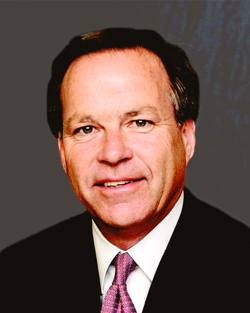
JACK B. MOORE, President and CEO, Cameron, and Chairman, National Ocean Industries Association
I recently read with interest an NBC news story about the Bakken shale oil boom in North Dakota that is creating thousands of American jobs. According to the report, job seekers from all 50 states are flocking to the town of Williston, whose population has nearly doubled from 12,600 to 23,000. While the nation’s unemployment rate hovers around 9%, Williston’s is less than 1%. What’s more, the jobs can’t be filled fast enough—for every job that is filled, another 1½ jobs open up!
While a boom in the oil and gas industry is great news, I was left asking myself, “Why isn’t this happening offshore as well?” One reason for the difference is regulatory climate. The vast resources of the Bakken lie mostly on private land, free from federal regulation. As those of us in the offshore energy industry know all too well, the same cannot be said for the US outer continental shelf (OCS). Production of our vast offshore oil and gas resources continues to be stymied by bad policies that have kept most of the OCS off limits to exploration for 30 years, as well as an increasingly restrictive regulatory environment.
Thankfully, jobs and energy are among the top issues in Washington, D.C., and the offshore energy industry is part of that discussion. A 2011 study of the economic impact from E&P in the Gulf of Mexico confirmed what we in the industry already know: The offshore industry is a major contributor to our national economy. The study concluded that if permitting were restored to historic levels, 190,000 new jobs would be created by 2013.
Co-commissioned by the National Ocean Industries Association (NOIA) and the American Petroleum Institute (API), and conducted by Quest Offshore Resources, the study shows that, in 2008, the offshore industry in the Gulf of Mexico pumped more than $30 billion into the US economy and supported more than 300,000 American jobs—not just in the Gulf, but across the nation. Even in 2010, which we all know was a tough year for our industry, operational and capital investment spending surpassed $26 billion and supported more than 240,000 American jobs.
What’s more, the Quest study estimates that operational spending could exceed $44 billion by 2013 and support nearly 430,000 US jobs. But all that is contingent on permitting levels being restored to historic levels and the backlog of E&P projects moving forward at a brisker pace.
In a time of record high unemployment and monumental state and federal deficits, the economic benefits of new Gulf drilling permits cannot be ignored. While much of the debate over the post-Macondo, post-moratorium slowdown has focused on the issuance of permits, new data from the regional economic development alliance Greater New Orleans Inc. paints a more complete picture. At present, the average approval time for a drilling plan is 118 days, compared with the historical average of 61 days. And when the plan is preceded by the newly required environmental assessment, its average approval time stretches to 227 days.
Uncertainty caused by the moratorium and slow processing of plans and permits has resulted in an exodus of rigs from the Gulf of Mexico. In testimony before the House Natural Resources Committee in October, Quest Resources reported that 11 rigs had left the Gulf since the beginning of the moratorium—seven for African countries, three for South America and one for Vietnam. Only one of those rigs had returned by October, and three rigs were sitting idle. In addition, at the end of September, 21 floating rigs were operating in the Gulf, vs. 33 pre-moratorium. That’s about a 37% drop.
In the wake of the Gulf oil spill, our industry has reviewed, revamped and instituted changes to prevent a Macondo-like well accident from occurring again. While deepwater operations will never be without risk, the safety and review measures now in place have greatly assisted in identifying and minimizing these risks. The industry also took the initiative to develop the Marine Well Containment Company (MWCC) and the Helix Fast Response System. As a condition of new permits to drill in the deepwater Gulf of Mexico, the federal government now requires companies to prove they have access to spill-containment equipment built to withstand worst-case blowout scenarios. MWCC and Helix offer drilling companies access to just such equipment.
In addition to providing energy and jobs and stimulating the national economy, the OCS generates revenue for the cash-strapped federal government. In 2008, the offshore oil and gas industry paid $17.9 billion in royalties, rents and bonus bids. With a slower economy and no lease sale held in more than a year, that number declined to $5.2 billion in 2010 and it will likely drop further for 2011.
Those who live, work and recreate in the oceans and coastal areas of the US clearly understand their tremendous value to our quality of life. They are important to our nation’s health and well-being while also serving as a tremendous economic and energy security benefit. With the right policies in place, the offshore energy industry can be a major contributor to new job growth and new federal revenues that will help alleviate the substantial debt the nation faces.
It is happening onshore. Why not offshore as well? 
THE AUTHOR
|
| JACK B. MOORE is President and CEO of Cameron, which he joined in 1999 as a Vice President in the Drilling and Production Systems group. Prior to joining Cameron, he held various management positions with Baker Hughes, where he was employed for 23 years. Mr. Moore holds a BBA degree from the University of Houston and is a graduate of the Advanced Management Program at Harvard Business School. He serves on the boards of directors of API, PESA and NOIA, where he is currently the Chairman. |
|



